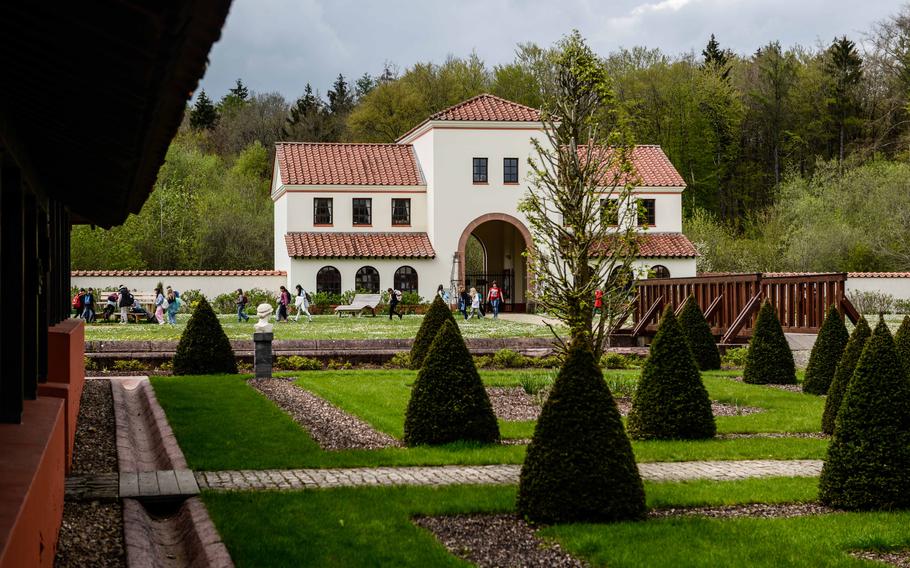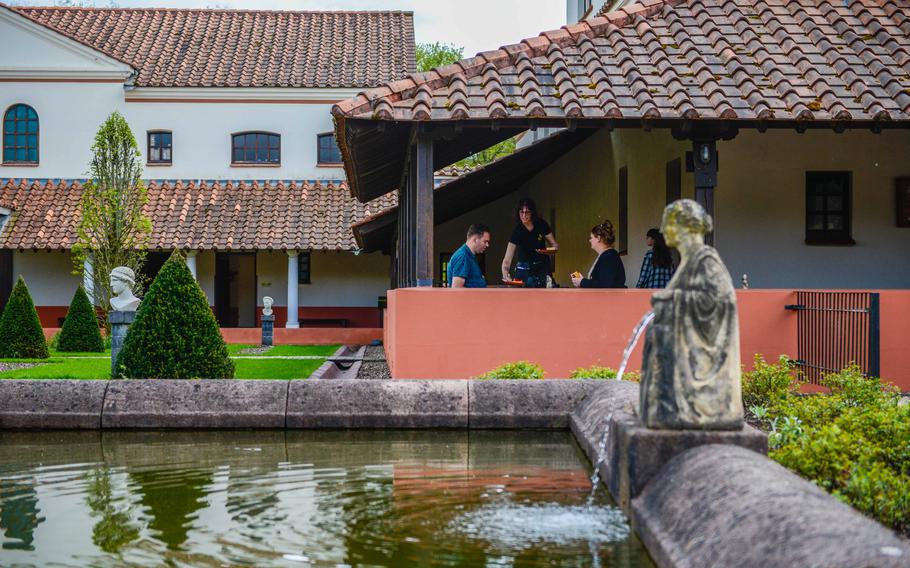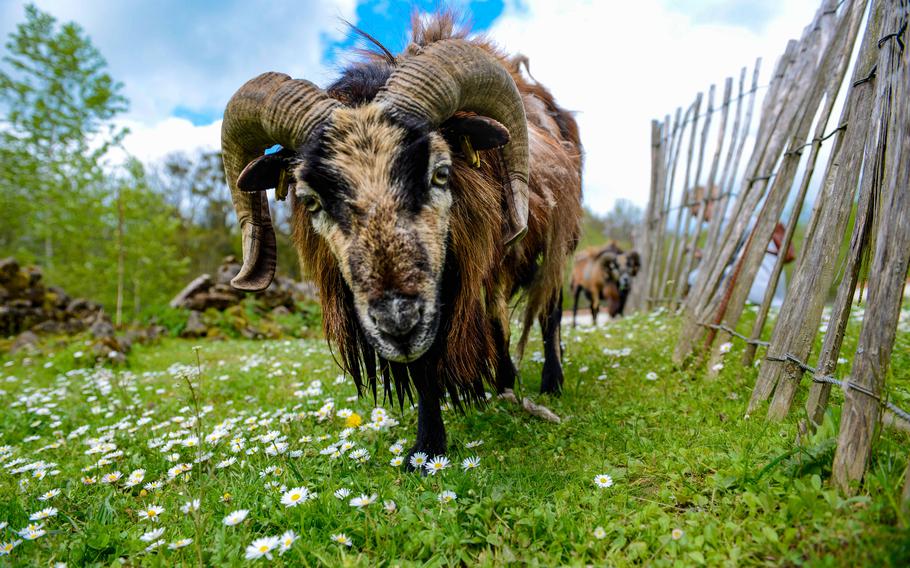
A group of school kids walk along the large gatehouse at Roman Villa Borg, May 2, 2023. The gatehouse was once the main entrance to the villa and features a large arched doorway built on the original site of the archaeological find. (Alexander Riedel/Stars and Stripes)
Attentive travelers in Germany can find evidence of the far-flung and fearsome Roman Empire, though most of these sites offer little more than traces to spark the imagination.
But in the heart of Saarland, near the German-Luxembourg border, lies Villa Borg, a fully restored Roman building complex whose splendor is readily reminiscent of the glory days of the Caesars.
On a recent Tuesday, my wife and I visited this ancient estate, which was surrounded by yellow springtime carpets of canola fields in bloom.
After the morning school groups left, we had the villa nearly to ourselves and perused its halls in peace and quiet, almost like its owners could have done nearly 2,000 years ago.

Guests dine at the Villa Borg Tavern on the grounds of the restored Roman villa in Borg, Germany, May 2, 2023. The tavern serves a variety of Roman-style dishes and modern Italian and local favorites, such as pasta and Lucanian sausages. (Alexander Riedel/Stars and Stripes)
In 1994, Villa Borg was meticulously constructed on top of the original site based on archaeological finds in the region and is the only one of its kind in the world, according to the local culture foundation of Merzig-Wadern, which supported its construction. The estate comprises six buildings, stables and manicured gardens to explore.
A large gatehouse at the entrance stands on its original foundations and reflects its condition in the second and third century, according to the visitor’s guide.
We then crossed over a small pond and through the center gardens to the main house.
We felt transported back to a world where the head of the house, the dominus, would have welcomed his guests in the magnificent foyer. The coffered ceilings and frescoed walls would have framed a detailed mosaic floor, which was unfortunately lost to history.
Visitors can explore the kitchen, the dining room, the study and the sleeping quarters. Each room is furnished with period replicas and features interactive exhibits that provide insight into the daily lives of privileged Roman settlers in Germania.
In the living area, we saw Roman leisure pursuits such as dice and board games and even tried on linen garments and shoes to make us feel right at home.
One of the highlights of the visit is the reconstructed Roman bathhouse, complete with maritime-themed frescoes, a deep indoor pool and a smaller tepidarium, a kind of sitting tub akin to today’s whirlpool.
Visitors also can explore the gardens and orchards, which feature plants and fruit trees commonly found in Roman times. There are also demonstrations of ancient crafts and trades, such as pottery-making and blacksmithing.
Excavation work continues at Villa Borg, which covers an area of more than 18 acres and was originally discovered by Johann Scheider, a school teacher, more than 100 years ago.
A nearby archaeological site found during construction for the villa in the 1990s shows what Villa Borg looked like before its renaissance. Gray remnants of walls trace the outline of another building, which once served as a way stop along an ancient Roman road from Trier to the French city of Metz.

A Cameroon dwarf blackbelly sheep grazes at Roman Villa Borg, Germany, May 2, 2023. It is unclear when this species came to Europe. At Villa Borg, the sheep represent the animals Roman settlers in Germania likely kept. (Alexander Riedel/Stars and Strip)
After exploring the villa, we dined in the tavern, enjoying Roman-style grilled fish with buttered potatoes and gnocchi in tomato sauce.
It’s worth noting that the first official gnocchi recipe is attributed to the Roman gourmet Marcus Gavius Apicius, dating back to the first century.
For those interested in enhancing their enjoyment of Villa Borg, I recommend attending Roman Days, held every year during the first weekend in August. Traders, craftsmen and even legionnaires and gladiators put up their camp on the estate and bring ancient Rome to life again for us denizens of the 21st century.
On the QT
Archaeological Park Roman Villa Borg
Address: Im Meeswald 1, Perl-Borg, Germany
Hours: During the summer months, daily except for Mondays, and tickets are available from 10 a.m. to 6 p.m. In February, March and November, hours are shortened to 11 a.m. to 4 p.m. Closed December and January.
Cost: Admission is 6 euros for adults and children 15 and older, 2 euros for children ages 6 to 14, and free for children under 6.
Information: Online: villa-borg.de. For group events, contact info@villa-borg.de